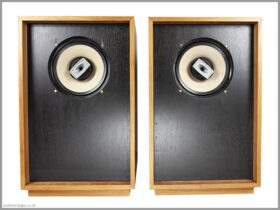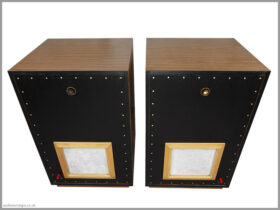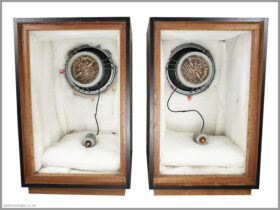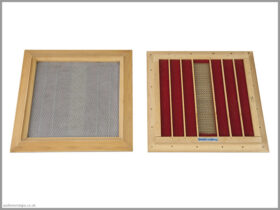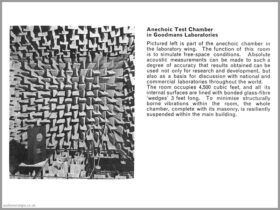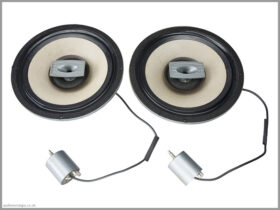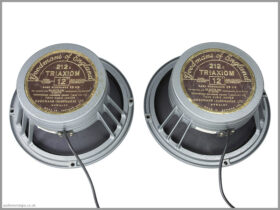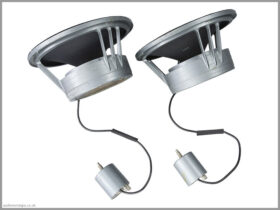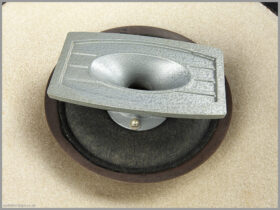TABLE OF CONTENTS
MY STORY WITH GOODMANS TRIAXIOM 212C
My story with Goodmans Triaxiom 212c is closely related to my review of Goodmans Triaxiom 1220c. I was looking for some period correct cabinets to review the 1220c drivers in, and came across some cool looking enclosures on eBay. Apart from being in really good condition, these cabinets also featured sought-after Goodmans’ ARUs – their proprietary acoustic vents. These enclosures seemed perfect for the Goodmans drivers, and I decided to purchase them. Upon collection, it turned out that they already contained drivers in them! Better yet, when I inspected the drivers at home, it turned out that both drivers were fully operational Goodmans Triaxiom 212c. This is how accidentally, I was given an opportunity to review these rare drivers side by side with my 1220c drivers.
Please note – Before reviewing these speakers I have replaced capacitors in the crossovers. The original capacitors were way out of spec, which is expected considering their age. Due to this, my views regarding these Goodmans Triaxion 212c speakers are based on listening to them after the upgrade. Also, bear in mind that purchasing vintage speakers is always a gamble. 60 years is a long time, and one can never be sure how this time affected the loudspeaker drivers. Consequently, even if you upgrade the crossover components, it is possible that your Goodmans Triaxiom 212c drivers will measure and sound different than the pair I reviewed.
SPEAKER INFO
History
At one time, Goodmans was the largest loudspeaker manufacturer in Europe with their own anechoic chamber (as shown in the image below). Today, the Goodmans name is found on everything from inexpensive portable music devices to TVs, leading many to associate the brand with low quality. Nonetheless, this wasn’t always the case and during their heyday, Goodmans produced some high-quality products.
It’s important to remember that the Hi-Fi market in the 1950s and 1960s was very different from today. Few companies offered finished loudspeakers. Often, you had to buy drivers and crossovers separately and then build your own cabinets using plans provided by the manufacturer.
This was the situation with the Goodmans Triaxiom 212c. As you can see in the brochure scan, Goodmans suggested a couple of enclosure options. It’s worth noting that due to the driver’s design which features a lightweight cone, a very large cabinet was necessary to achieve decent bass response, which is reflected in the enclosure plans provided by Goodmans.
Driver’s Design
Goodmans Triaxiom 212c is a coaxial driver, meaning that both the woofer and tweeter are aligned on the same axis. This design was quite popular during the 1960s, with several manufacturers like Tannoy, Altec, and Coral experimenting with similar approaches. Goodmans marketed these speakers as three-way drivers, which is why “tri” is included in the name. The presence of a whizzer cone attached to the woofer was promoted as the midrange driver. However, from a technical perspective, these are really two-way drivers, featuring a 12-inch cone and a horn tweeter mounted at the center of the driver.
GOODMANS TRIAXIOM 212C SPECS
| Frequency Response: | 30 – 20,000Hz (+/- 6dB) |
| Sensitivity: | Unknown |
| Impedance: | 8Ω |
| Power Capacity: | 15W |
| High Frequency Driver: | Horn Loaded 25mm (1″) Aluminium Diaphragm |
| Low Frequency Driver: | 300mm (12″) Vacuum Formed Paper Diaphragm |
| Crossover Frequency: | 5,000Hz |
| Free Air Resonance (FS): | 35Hz |
| Weight: | 5.1kg (each driver) |
| Production Year: | 1964 |
| Price When Launched: | £36 for a pair |
| Equivalent Present Day Price: | £600 for a pair |
| Current UK Price: | £300 to £500 for a pair |
LOOK & FEEL OF GOODMANS TRIAXIOM SPEAKERS
Goodmans Triaxiom 212c have a substantial appearance, especially when compared to modern drivers that use plastic or pressed steel baskets. These vintage drivers feature cast metal baskets that encase the magnets assembly, creating the impression of a larger motor structure than it actually is.
The woofer cones are made of paper, coated with a type of lightweight foam that has a texture reminiscent of expanding foam. The cone surround is made from a flexible plastic that shows slight wrinkling in some areas, but otherwise exhibits no signs of deterioration. This suspension has held up for 60 years and it is likely to last another 60.
The tweeter consists of a small-diameter diaphragm housed in a fairly substantial metal horn, which complements the overall design nicely. The crossover is enclosed in a sturdy metal canister.
All in all, I’m quite impressed with the build quality of these drivers.
SOUND OF GOODMANS TRIAXIOM 212C
First Impressions
Having just finished reviewing Goodmans Triaxiom 1220c, I did not expect anything radically different from Goodmans Triaxiom 212c, especially as both drivers are practically identical in construction. And this was indeed the case. When I connected the 212c drivers for the first time – they produced a fair amount of bass in these large cabinets. The feeling was perhaps further emphasised by rather shy treble output, even though the speakers were tilted up to point the tweeters directly at my ears.
Bass
By modern standards, these test cabinets are huge. Most people looking at speakers of this size would not assume that bass extension is something that may be a problem. However, Goodmans Triaxiom 212c have rather light diaphragms and a low Q, so despite the large enclosures, I had concerns about bass extension. It turned out that my concerns were unjustified. I believe most listeners will find the bass output in these large enclosures satisfying. On the other hand, there are some tracks that benefit from sub bass. For instance, on Into My Arms by Nick Cave & The Bad Seeds, there is a really low foot taping noise about 1:30 into the track, which I’m accustomed to hearing on my Dutch & Dutch 8c, and I could not hear that on the Triaxiom 212c.
It’s also important to mention that although bass instruments sound decent on their own, when multiple instruments play simultaneously, the sound can become congested, making it difficult to distinguish between them. So, while the bass quantity is respectable, the resolution isn’t quite as impressive.
What truly surprised me was the effortless sound these speakers deliver—it’s clear you’re listening to large speakers. Goodmans Triaxiom 212c are also much more efficient than many modern speakers. I noticed that the amplifier was set about 6dB lower than usual when playing music. That said, their power handling is on the low side, and as such, I didn’t push them to test how they’d handle disco-level volumes. But if you’re considering these drivers, it’s likely that’s not what you intend to use them for anyway.
Although it’s not directly related to the drivers, it’s worth mentioning that the Goodmans ARUs (acoustic vents made by Goodmans) are poorly designed because they tend to rattle. The external metal mesh can vibrate, creating noticeable noise at low frequencies. This is very noticeable on tracks such as Ode To Boy by Alison Moyet. Thus, if you’re planning to build speaker cabinets with these drivers and are thinking of using Goodmans ARUs, you might want to reconsider. With some effort, you could likely create much better-performing alternatives.
Midrange, Treble, and Soundstage
Moving on from the bass, let’s delve into the midrange and treble, where I’m afraid things become less impressive. While voices sound decent, there’s a noticeable absence in the upper registers, making Goodmans Triaxiom 212c seem a bit muffled. This lack of clarity impacts the spatial cues in the recording, leaving you without a sense of where the recording took place. The same issue affects guitar reproduction; while the body of the guitar comes across nicely, the high-end sparkle is missing. This also dulls elements crucial to live recordings, like clapping, which in turn makes live albums less enjoyable. This issue is evident on tracks such as Fly Me To The Moon by Tony Bennett from his MTV Unplugged album, where the atmosphere of the recording just does not come through.
The soundstage also leaves much to be desired. There’s little sense of depth or the location of sound sources within the soundstage. Combined with the lack of upper registers, this makes it hard to become engaged with the music. For example, with speakers like the Celestion Ditton 66, you immediately get drawn into the music, wanting to listen more as soon as one track ends. This isn’t the case with the Goodmans Triaxiom 212c. Saying that, there were some tracks that suited these speakers. One of them was The Wolf by Darondo which sounded quite good. But this is an exception rather than the rule. Although Goodmans Triaxiom 212c provide pleasant enough sound for background listening, they failed to captivate me during critical listening.
Redesigning the crossovers might improve the performance of these drivers, but I doubt the difference would be significant enough to justify the effort.
CONCLUSION
I have a deep appreciation for the look of these drivers and the nostalgia they evoke, but their sound quality falls short. As of this review, they are nearly 60 years old, and while the basic principles of loudspeaker design have stayed the same, significant advancements have been made in material science and our understanding of acoustics. If you’re a vintage loudspeaker collector, the Goodmans Triaxiom 212c are a remarkable piece of audio history. However, if you’re seeking high-fidelity sound, there are far better options available today.
| Balance of Sound: | |
| Neutrality of Tone: | |
| Transparency: | |
| Soundstage: | |
| Attack: | |
| Engagement: | |
| Total Score: |
SONGS MENTIONED IN THIS REVIEW
Alison Moyet – Ode To Boy
Darondo – The Wolf
Nick Cave & The Bad Seeds – Into My Arms
Tony Bennett – Fly Me To The Moon (MTV Unplugged)
Reviewed: August 2023 | Published: August 2024



